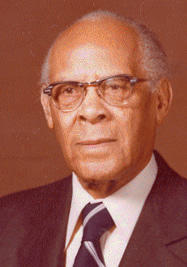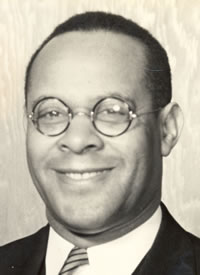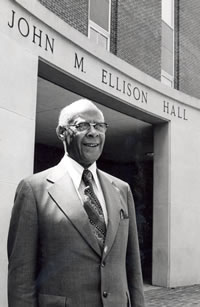Dr. John Malcus Ellison, Sr.(1889-1979)
|
|
| Born February 2, 1889 in Northumberland County, Virginia, John Malcus Ellison, Sr. was one of twin sons. His early life was very humble, allowing for little intellectual stimulation beyond learning to read in the segregated schools of his rural community. Quoting Ellison from a short autobiographical sketch he wrote in the late 1950's: |
 |
“At the
age of 14, I was hired out for $7 per month as a farm hand.
My varied experiences caused me much unrest and anxiety as
I longed for a fuller and more meaningful life. Opportunities
for education were very meager in my home community, and
so at the age of 17, I went to Normal Industrial Institute – now
Virginia State College at Petersburg, Virginia. After two
and one half years of study I transferred to Virginia Union
College in 1909 and completed my degree."
|
At that time, Wayland Academy was the division of Virginia Union University (VUU) that provided secondary education to students. After earning a Bachelor of Arts from Wayland Academy in 1917, Ellison returned to his home county where he taught and preached for several years.
In 1927 Ellison earned a Master of Arts in Theology from Oberlin College in Ohio, and subsequently taught sociology and ethics at Virginia State College (VSC). While at VSC, he became the college’s first minister. By 1933, Ellison had earned his Ph.D. in Christian Education and Sociology from Drew University, founded Northumberland County High School, pastored Zion Baptist Church in Washington, DC, taught Religious Education at Howard University’s School of Religion, and authored several publications on rural, Negro life in Virginia. It was in that same year that he married Elizabeth Balfour, a music educator and performer from Brooklyn, New York.
|
| The Ellison Years as President (1941-1956) |
| Dr. Ellison assumed the VUU presidency at a very difficult time in national and international history. The country had just entered World War II and Jim Crow was the law of the land in the South. While generally considered a success as president, as the first African American to take the helm at VUU, Dr. Ellison lived with the burden of proving himself capable and worthy of the position. (Dr. Malcolm MacVicar was president from 1899-1904, Dr. George Rice Hovey was president from 1904-1918, and Dr. William J. Clark was president from 1919-1941.) In spite of the manpower drain on both student body and faculty, Union survived the worst of times and in 1946 when the GI's returned to school, prosperity and stability returned to the university. It was during Dr. Ellison’s administration that the Belgian Friendship Building project was completed. |
 |
| Belgian Friendship Building |
After the 1939 World’s Fair in New York City, the Belgian government could not dismantle and return their elaborate exhibit and its housing to war-torn Europe. Several options were explored to dispose of the splendid structure originally designed to be a college in Belgium. Benefactors of Negro education, however, won out. The Belgian Friendship Building, with its bas-reliefs depicting black life in the Belgium Congo, was relocated to the campus of Virginia Union University in Richmond, Virginia.
Negotiations for the building’s transfer of title and property began in Dr. Clark’s time; fund raising, re-design and physical relocation were left to Dr. Ellison’s stewardship. By 1949 the campus had been renovated, the Belgian building and was fitted for science, library and gymnasium use. An indebtedness of nearly $500,000 dollars had been retired under Dr. Ellison’s leadership. This was project that was a major concern during the first half of his career and his papers reflect its importance.
During the Ellison administration, The Belgian Friendship Building was used as an “induction site” by the US War Department for draftees entering World War II. From 1943 until 1947, 161,000 individuals from eastern Virginia were processed in the “central examining station.” Of that number 40,236 were selected for military service. (Richmond News Leader, Feb. 4, 1943, p.3 and July 24, 1947 p. 23, Ellison letter Jan. 14, 1944, VUU Archives) Watkins Oct. 2006.
Improvements on the campus followed the Belgian Building project including reorganization of the university’s administrative structure, significant increase in the endowment, and additions to the physical plant (e.g. Hovey Stadium, new dormitories and other facilities.) |
| Ministerial and Community Life |
Concurrent with his academic and administrative career, Dr. Ellison kept an active ministerial career preaching and teaching throughout Virginia on a regular basis and appearing as guest pastor at various churches, Sunday Schools and conferences all over the country. Summers were often spent teaching aspiring ministers in special programs that he helped design. He edited religious journals and newsletters, as well as both the Scottish Rites periodical publication and that of Alpha Phi alpha Fraternity, Inc. His love for writing was further demonstrated by his prolific authorship of several books, tracts and brochures; his extensive notes in preparation for writing a definitive history of Virginia Union are a part of a special collection of his papers. A wealth of his sermons, articles and speeches are also available.
As a prominent African American leader (then called Negro), Dr. Ellison was active in many organizations advancing the cause of both civil rights and higher education for his race. He frequently corresponded with presidents and principals of other black institutions about issues facing African Americans. The success or failure of the schools depended upon their leadership and tenacity. Both men and women administrators were active in this support network as evidenced by correspondence from Nannie Burroughs, Mary McLeod Bethune, and Charlotte Hawkins Brown, along with Dr. Benjamin Mays, Dr. Mordecai Johnson, Dr. F.D.Bluford and Dr. Miles Connor; all prominent leaders of black educational institutions. Their involvement with organizations such as the National Youth Administration, Southern Education Foundation, Negro Organization Society, National Conference of Church-Related Colleges, the NAACP and others was cooperative and extensive, supporting the existence and survival of their students and their schools. |
In 1968, John M. Ellison Hall was built and named in honor of the former chancellor and fourth president of the University. The academic building provides space for the Offices of Academic Affairs, the Registrar, Wall Auditorium, ample classrooms and laboratory space for the various disciplines.
Note:
Among the many contributions by Dr. Ellison included are: the organization of the college into various departments to modernize the university, the development of the College Inn, and development of an annual Fine Arts Festival that brought celebrated artists to the university and the development of a partnership with area colleges to bring outstanding experts in varying fields of study to their campuses. After Dr. Ellison retired from the presidency and served as its Chancellor, he was appointed by the American Baptist Convention as Educational Consultant to 20 of its colleges. He was minister of St. Stephens Baptist Church in Caroline County, Virginia. One of Dr. Ellison’s cherished accomplishments was that a hospital was named for him in Owerri, Nigeria West Africa. |
 |
| |
| |
| |
|
|
|
All Bells for Peace contents on the Website are: Copyright © 2006-2007 - BellsForPeace.org
All rights reserved. |
|


